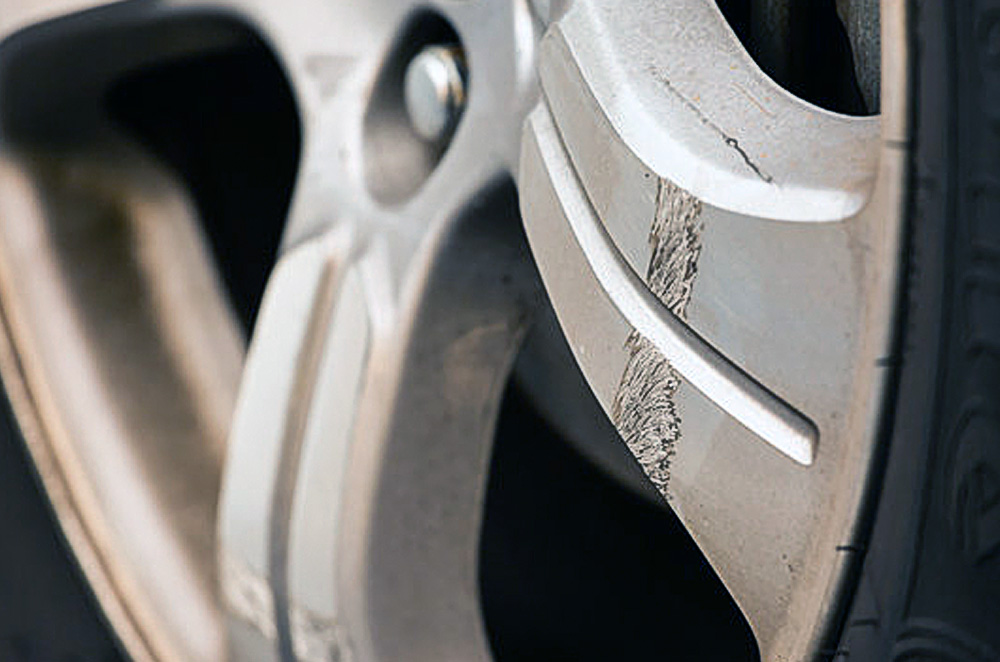
We’re all familiar with the types of tire damage, but what about the wheels? While wheels are generally durable and can last many years, they’re still susceptible to the normal wear and tear caused by daily driving.
Proper wheel care is an essential part of a complete car maintenance regimen. Whether you’re driving a bonafide off-roader like the Ford Ranger Raptor, or a small hatchback like the Toyota Wigo, wheel damage is always something to look out for. If your rims are not well-maintained, you can and will run into trouble down the line. With that said, here’s a quick guide on the most common types of wheel damage and how you can identify and prevent them.
Dented wheels

Dents are the first type of wheel damage you should be aware of. Also known as bengkong here in the Philippines, dented or bent wheels can become a serious issue. There are several different ways in which you can dent your wheels. Hitting a pothole, for example, is a common cause of dented rims. Depending on your speed and the depth of the pothole, this can cause significant damage. You can also damage a wheel in a collision. If this happens, the wheel may go out of alignment and cause steering problems.
You can identify dent damage in your wheels by noticing poor handling, decreased fuel efficiency, steering wheel vibration at higher speeds, and a persistent beating sound that gets faster with acceleration. Dented wheels may also cause flat tires or even tire blowout.
Fixing a dented wheel
While some dents can be straightened professionally, some are simply beyond repair. Depending on how severe the dent is, the wheel may need to be replaced outright if it has sustained significant damage. The reason being that driving with dented rims can be dangerous. In some cases, steering may become difficult, and the vehicle may even wobble at high speeds. Remember, if a dent is too large to repair, it's best to replace the wheel.
Cracked wheels

Similar to dented wheels, cracked wheels can occur after colliding with potholes, speed bumps, curbs, or another vehicle. If one of your rims is cracked, you may notice some instability at higher speeds and a repetitive thumping sound that won't go away. Cracked wheels can also cause flat tires or blowouts in addition to negatively affecting your car's handling and mileage.
Fixing a cracked wheel
Smaller cracks can be fixed by straightening the damaged area of the wheel. With larger cracking, however, the structural integrity of the wheel can be compromised. When the damage is too big, the cracked wheel may no longer be safe to use and should be replaced. A professional will be able to assess if specific cracks are suitable for repairs or replacement.
Wheel corrosion

Corroded wheels are not only unsightly, but they can be dangerous as well. Wheel corrosion can be caused by road chemicals, chemical cleaners, tire sealants, and other elements. Rusted rims can quickly deteriorate, especially when constantly exposed to water. When left untreated, rust continually eats away at the metal in the wheels. If the corrosion reaches the tire bead, it can also make it harder to maintain tire pressure.
Fixing wheel corrosion
Minor corrosion can be fixed by using a steel brush and wheel cleaning solution. If you decide to go this route, make sure you apply the solution sparingly and only where corrosion is present. Wheel cleaning solutions can damage wheels and tires if left for a long time. If you encounter major wheel corrosion, however, wheel replacement is advisable.
Curb rash

Curb rash is another common type of wheel damage. You may encounter curb rash if you accidentally scrape your wheel on concrete curbs or other road hazards. A layer of chemical coating protects most alloy and metal wheels, but that coating can come off if you scrape the wheel surface. If this happens, the bare metal rims underneath can be exposed to scratches, scuffs, and even rust.
Fixing curb rash
Minor curb rash can usually be fixed at home. For alloy rims, you'll need sandpaper to file down the damage and, in some cases, automotive spot putty to fill everything in. Depending on how big the scuff is, you may need to repaint the entire wheel to match the original rim color. For particularly large scuffs, we recommend you consult a professional for wheel repairs or replacement.
Latest Features
-
An all-electric future: The Porsche Macan Electric / Featured Article
Porsche’s Macan goes all-electric; it’s a new beast with an electrified heart, yet unmistakably Porsche in performance and spirit.
-
Which Kia should I buy? / Featured Article
We’re here to help you decide which Kia vehicle is best for you, whether it’s a sedan, crossover, or minivan.
-
Why Lynk & Co is a good option for luxury car buyers / Featured Article
Lynk & Co offers premium value for those exploring the luxury market.
Popular Articles
-
Electric Vehicles in the Philippines for under P1 million
Jerome Tresvalles · Aug 19, 2025
-
Top 3 Cars For Every Lifestyle—What Cars Are Right For You? | Behind a Desk
Caco Tirona · Apr 24, 2024
-
5 Tips to Maximize Fuel Efficiency
Jerome Tresvalles · Sep 09, 2024
-
Five driving habits that are draining your fuel tank
Jerome Tresvalles · Jun 24, 2025
-
Can engine braking harm your engine?
Jerome Tresvalles · Sep 11, 2025
-
Do electric cars even need maintenance?
Jerome Tresvalles · Oct 23, 2024
-
Best vehicles for an active outdoor lifestyle
Shaynah Miranda · Jul 25, 2024
-
How to drive different types of vehicle transmissions
May 23, 2024
-
5 easy ways to keep your car interior clean
Allysa Mae Zulueta · Nov 15, 2021
-
How to survive Metro Manila traffic
Earl Lee · Aug 16, 2022



